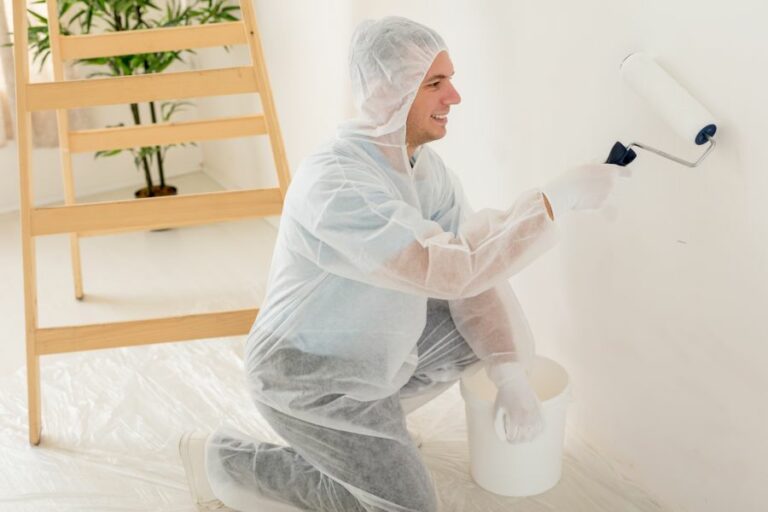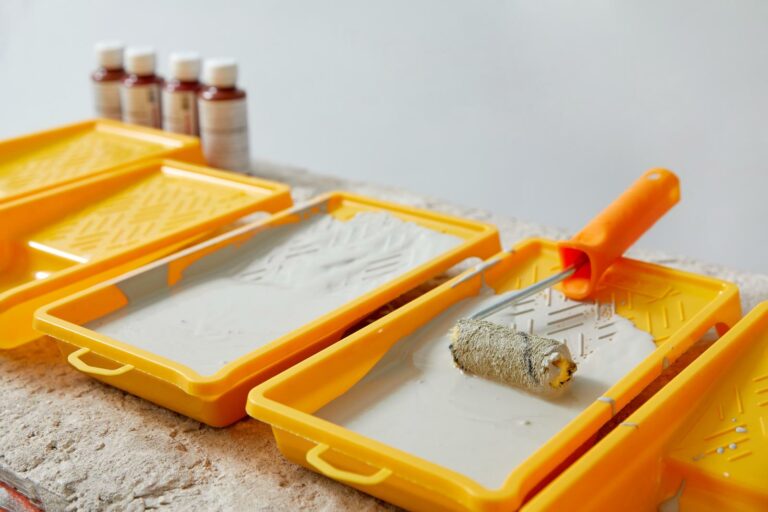Natural Indoor Paint Alternatives, 25 Things You Should Know
Are you looking to refresh your home interior while keeping environmental impact, health, and safety in mind? We understand the desire to use natural alternatives and avoid harmful chemicals typically found in commercial paint. Fortunately, we can help you explore natural indoor paint alternatives that provide outstanding results, protect your health, and are environmentally friendly.
Natural indoor paint alternatives:
Natural indoor paint alternatives include low-VOC and zero-VOC paints, plant- and mineral-based paints, milk paint, and lime paint. These eco-friendly options offer good indoor air quality, reduced environmental impact, and often have added benefits like antimicrobial properties or biodegradability. Popular brands include Benjamin Moore’s Natura, ECOS Paints, RomaBio, Real Milk Paint, and St. Astier Natural Hydraulic Lime.

Discover a world of environmentally friendly and health-conscious paint solutions for your home! Swap out harsh chemicals for natural ingredients, and brighten up your living space the eco-friendly way. Keep reading to explore various natural indoor paint alternatives that are not only good for you but also for the environment.
Contents
- 1 Eco-Friendly Interior Paint Substitutes
- 2 Top Environmentally-Conscious Paint Options
- 3 The Existence of Sustainable Paint Choices
- 4 Discovering Scent-Free Interior Paints
- 5 Exploring the Availability of No-VOC Paints
Eco-Friendly Interior Paint Substitutes
As concerns for the environment and human health continue to rise, many homeowners are looking for natural indoor paint alternatives to standard commercial products.
Traditional paints can emit volatile organic compounds (VOCs) that cause various respiratory issues and contribute to air pollution. Thankfully, there are several eco-friendly options to choose from.
• What are VOCs and Why are They Harmful?
Volatile organic compounds (VOCs) are chemical compounds found in many common household products, including paints, glues, and solvents.
When these compounds are released into the air, they can cause adverse health effects such as eye, nose, and throat irritation, headaches, dizziness, and even damage to the liver, kidneys, and the central nervous system.
The United States Environmental Protection Agency (EPA) lists VOCs as one of the top five indoor air pollutants, making it essential to consider alternatives when painting your home.
• Natural and Low-VOC Paint Alternatives
– Low-VOC and Zero-VOC Paints
Many manufacturers now offer low-VOC and zero-VOC paints as more eco-friendly alternatives to traditional options. These products contain little or no volatile organic compounds, ensuring good indoor air quality and less environmental impact.
One example of such paint is Benjamin Moore’s Natura. This zero-VOC paint is not only eco-friendly but also has excellent coverage and durability.
– Plant- and Mineral-Based Paints
Plant- and mineral-based paints are another excellent choice for those wanting a more sustainable option. These paints are made from natural ingredients such as clay, lime, and plant oils. They are biodegradable, making them better for the environment than their synthetic counterparts.
A popular plant-based paint option is ECOS Paints. Their products have been certified by the Asthma and Allergy Foundation of America, meaning they are safe for people with these conditions.
For mineral-based options, an excellent choice is RomaBio’s paint line. Their paints are made from primarily natural, biodegradable materials, free of VOCs and other harmful toxins.
– Milk Paint
Using milk as its primary binder, milk paint is a natural option that has been in use for centuries. This paint is known for its durability and beautiful, rustic look.
One drawback of milk paint is that it does not adhere well to previously painted surfaces, meaning it is best suited for raw wood or other porous materials.
One notable brand offering milk and chalk-based paint options are Real Milk Paint. Their products adhere well to various surfaces and provide a beautiful finish, making them a go-to choice for homeowners looking for a natural, eco-friendly option.
– Lime Paint
Lime paint is a natural and breathable alternative to standard paints. Made from limestone or calcium carbonate, this paint is beautiful, durable, and has antimicrobial properties, making it great for humid areas such as bathrooms or kitchens.
However, lime paint is best suited for mineral substrates such as brick, concrete, or plaster, as it does not adhere well to painted surfaces or certain types of wood.
One well-respected brand of lime paint is St. Astier Natural Hydraulic Lime. Their paints come in a variety of colors and offer a beautiful, smooth finish that is perfect for traditional or modern home styles.
• Application Tips and Tricks
- Before applying any natural paint alternative, be sure to clean and prep surfaces adequately. Remove any peeling paint, dirt, or debris, and ensure the surface is clean and dry.
- When using low-VOC or zero-VOC paint, be sure to follow the manufacturer’s guidelines for surface preparation, application, and drying times.
- If using milk paint, it is crucial to remember that it comes in a powdered form and must be mixed according to the manufacturer’s instructions. Additionally, if applied to a non-porous surface, a bonding agent may need to be mixed in to improve adhesion.
- When working with lime paint, be sure to apply thin, even layers and allow adequate drying time between coats.
As you can see, there are several natural indoor paint alternatives available for homeowners who are concerned about their health, indoor air quality, and environmental impact.
By choosing low-VOC, plant- and mineral-based paints, milk paint, or lime paint, you can have a beautifully painted home while reducing your exposure to harmful chemicals and supporting a healthier, eco-friendly lifestyle.
Top Environmentally-Conscious Paint Options
• Understanding Eco-Friendly Paints
Eco-friendly paints are designed to minimize their impact on the environment and human health.
They have low levels of volatile organic compounds (VOCs), which are chemicals released into the air as the paint dries. VOCs can cause respiratory issues, headaches, and other health problems, especially for those with chemical sensitivities.
Eco-friendly paints use sustainable ingredients and manufacturing processes to create products that are better for our planet.
– Natural Paints
Natural paints are made from renewable resources, such as plant-based oils, resins, and pigments. They contain no petrochemicals, making them a more sustainable option than conventional paints.
Natural paints emit fewer VOCs and tend to have a lower carbon footprint. Some popular natural paint brands include Auro and Earth Pigments.
– Zero and Low-VOC Paints
Zero and low-VOC paints are formulated to reduce the level of harmful chemicals released during the drying process. They are a popular option for many people seeking a more eco-friendly paint.
Major paint manufacturers, such as Sherwin-Williams, Benjamin Moore, and Valspar, offer a range of low and zero-VOC products. When selecting paint, look for the Greenguard certification, which indicates that a product meets strict criteria for low emissions of VOCs.
– Recycled Paints
Recycled paints are made from leftover paint collected and reprocessed to create new, usable paint. This process helps reduce waste and conserve resources.
Recycled paints can have a lower carbon footprint than conventional paints due to their use of existing materials. Some brands, like Amazon Environmental, provide recycled paint options.
– Milk Paint
Milk paint is a traditional, natural paint made from the protein casein found in milk, mixed with lime and pigments. It is a water-based, biodegradable paint with low VOCs and a unique, rustic appearance.
Milk paint can be used on furniture and walls but requires a sealer or topcoat for durability. One well-known milk paint brand is The Real Milk Paint Co.
• Choosing the Most Eco-Friendly Paint Option
While there are many eco-friendly paint options available, the most sustainable choice will depend on your specific needs and project requirements. Here are some factors to consider when selecting eco-friendly paint:
– Indoor or Outdoor Use
Some eco-friendly paints may not be suitable for outdoor use, while others may require additional protection against the elements. Be sure to check the paint’s label for any restrictions before purchasing.
– Durability
The durability of eco-friendly paints can vary, with some requiring more frequent reapplication or maintenance. Consider the intended use of the painted surface and whether a more durable, potentially less eco-friendly paint option makes more sense in the long run.
– Coverage
Some natural and eco-friendly paints may offer less coverage than conventional paints, meaning more coats may be required to achieve the desired result. Keep this in mind when calculating the cost and environmental impact of your chosen paint.
– Availability and Cost
Eco-friendly paints may not always be readily available at local stores, and their cost can be higher than conventional paint options. Be prepared to search online or visit specialty retailers to find the product that best suits your needs.
– Personal Sensitivities
If you have sensitivities to chemicals or odors, selecting a low or zero-VOC paint may be the best option to minimize discomfort and potential health issues.
• An Expert Recommendation
In my experience, the most eco-friendly paint option is natural paint. Natural paints, made from renewable resources, provide excellent sustainability benefits and emit fewer VOCs.
However, it is vital to consider the intended use of the paint, personal sensitivities, and the cost when selecting the most suitable eco-friendly paint for your project.
For more in-depth information on eco-friendly paints and their environmental impacts, check out the Environmental Protection Agency’s guide on green paint.
Type of Paint | Eco-friendliness |
|---|---|
Natural Paint | Most eco-friendly |
Zero VOC Paint | Eco-friendly |
Low VOC Paint | Less eco-friendly |
Traditional Paint | Least eco-friendly |
The Existence of Sustainable Paint Choices
In recent years, the demand for environmentally friendly products has grown exponentially, including in the realm of house paints. Many consumers and professionals alike wonder if eco-friendly paint is a reality or just a marketing gimmick.
• What Makes Paint Eco-Friendly?
Traditional paints contain harmful chemicals called Volatile Organic Compounds (VOCs). These compounds are released into the air when the paint is applied, and they can have negative impacts on both human health and the environment.
Eco-friendly paints are formulated with reduced or no VOCs, significantly improving indoor air quality and reducing environmental impact.
– Low-VOC and Zero-VOC Paints
Many paint manufacturers now offer Low-VOC and Zero-VOC paint options. These products meet stringent standards set by environmental and health organizations, ensuring that they have minimal impact on indoor air quality and the environment.
Examples of such organizations include the Environmental Protection Agency (EPA) and Green Seal.
– Natural Paints
Another category of eco-friendly paints is natural paints. These products are made from sustainable, plant-based ingredients, such as clay, lime, and plant oils. Natural paints have minimal or no VOCs, and they are biodegradable and non-toxic.
Additionally, some natural paints have antimicrobial properties, further contributing to a healthy indoor environment.
• Advantages of Eco-Friendly Paints
– Health and Safety
One of the most significant benefits of eco-friendly paint is the improvement of indoor air quality. Reduced exposure to VOCs can alleviate symptoms related to respiratory issues, allergies, and headaches.
The use of natural ingredients in eco-friendly paint also reduces the risk of toxic exposure to both humans and pets.
– Environmental Impact
Eco-friendly paints contribute to the reduction of air pollution, as they emit fewer harmful chemicals. Furthermore, the manufacturing process of these paints is often more sustainable and less resource-intensive.
Switching to eco-friendly paint supports the move toward a more sustainable and greener future.
– Performance and Aesthetics
In the past, eco-friendly paints may have been considered inferior in terms of performance and finish. However, advancements in technology and formulations have ensured that these products perform at par with conventional paints.
Today, eco-friendly paints offer a wide range of colors, finishes, and durability comparable to traditional paint options.
• Popular Eco-Friendly Paint Brands
There are numerous eco-friendly paint brands available in the market. Here are some popular options:
– Benjamin Moore
Benjamin Moore offers a range of eco-friendly paint options with their Natura line. These paints are certified as asthma and allergy-friendly by the Asthma and Allergy Foundation of America (AAFA) and have zero VOCs.
– Farrow & Ball
Farrow & Ball is a British paint brand renowned for its rich and luxurious colors. They offer eco-friendly paint options with their water-based Modern and Estate lines, which have low odor and are low in VOCs.
– BioShield
BioShield is an environmentally-friendly paint brand that offers natural clay, lime, and silicate paint options. Their products are solvent-free, low in VOCs, and biodegradable.
– Ecos Paints
Ecos Paints is a well-known eco-friendly paint brand that offers a wide range of products, from zero-VOC paint to varnishes and wood stains. Their products are certified by various environmental organizations, ensuring a high-quality, sustainable option for your painting needs.
• Tips for Using Eco-Friendly Paint
When choosing eco-friendly paint, always verify the product’s environmental claims and certifications. Be sure to check whether the paint has been certified by organizations like Green Seal, the EPA, or AAFA.
During the painting process, ensure proper ventilation by opening windows and using fans to circulate fresh air. Although eco-friendly paints emit fewer harmful chemicals, proper ventilation is always advised for maintaining optimal indoor air quality.
Lastly, consider the disposal of leftover paint. Many communities offer paint recycling programs, which ensure proper disposal and minimize environmental impact.
• Conclusion
There is indeed such a thing as eco-friendly paint, a category that has expanded to include numerous high-quality, sustainable options for consumers and professionals.
By choosing eco-friendly paint, you can contribute to a healthier living space and a reduced environmental footprint without sacrificing performance or aesthetics.
Discovering Scent-Free Interior Paints
Odorless indoor paint is a growing necessity for many DIY enthusiasts and professional painters alike.
The presence of strong odors, also known as volatile organic compounds (VOCs), in paint, can cause various health concerns and discomfort for those with sensitivities, including headaches, dizziness, and respiratory issues. Furthermore, long-term exposure to VOCs may lead to more serious health problems.
• The Quest to Find Odorless Indoor Paint
Odorless indoor paint has become an increasingly popular option for those seeking to avoid the unpleasant smell associated with traditional paints.
Although finding a completely odorless paint can be challenging, there are several options available in the market that have significantly low VOC content and negligible odor.
For instance, water-based paint, also known as latex or acrylic paint, has gained prominence as an eco-friendly and safer alternative to oil-based paint.
I recommend exploring the following types of low or zero-VOC paint for a healthier painting experience:
– Water-Based Paint
As mentioned earlier, water-based paint, such as latex or acrylic, contains very low levels of VOCs and has minimal odor during and after application.
A great advantage of water-based paint is its quick-drying, making it easier for you to complete your painting project with multiple coats in a short amount of time. Additionally, water-based paint offers a durable finish, making it suitable for a wide range of surfaces.
– Low and Zero-VOC Paint
Some paint brands have made concerted efforts to develop low and zero-VOC paint options. These paints are specifically designed to emit little or no odor, significantly reducing the risk of immediate and long-term health issues.
One example of zero-VOC paint is Sherwin-Williams’ Harmony paint line, which has GreenGuard Gold certification to ensure it meets strict chemical emissions standards.
Bear in mind that even zero-VOC paint may emit some odor due to other chemicals present in the mix, but the intensity is significantly lower than that of traditional paint products.
– Natural Paint
Natural paint is made from raw, organic materials such as plant oils, resins, and mineral pigments. This type of paint is biodegradable and free of synthetic chemicals, making it an excellent option for individuals with allergies or sensitivities to harsh chemicals.
One example of natural paint is Bioshield’s Clay Paint, which emits zero VOCs and offers a unique, earthy appearance. Keep in mind that natural paint can be more expensive than other options, but it’s definitely worth considering if you prioritize health and environmental consciousness.
• Safety Precautions When Using Odorless Indoor Paint
Regardless of the type of paint you choose, it’s important to take certain safety precautions during the painting process. Here are some tips to ensure a healthy and safe indoor painting experience:
- Ensure proper ventilation: Open windows and doors to facilitate air circulation while you paint. For rooms without windows, use exhaust fans. Additionally, consider wearing a mask designed to filter out paint fumes.
- Follow manufacturer’s instructions: Pay close attention to the usage and application guidelines provided by the paint manufacturer to avoid any adverse effects.
- Store paint safely: Keep paint containers tightly sealed when not in use and store them in a cool, dry place away from heat sources or flames.
- Dispose of paint responsibly: Follow your local regulations for paint disposal, as improper disposal can harm the environment and pose a risk to others when inhaled or ingested.
• Final Thoughts
In conclusion, finding completely odorless indoor paint can be challenging, but there are several options available that emit very low levels of harmful VOCs. By considering water-based, low VOC, or natural paint options, you can create a healthier painting environment for yourself and others in the vicinity.
Furthermore, taking proper safety precautions during the painting process will further minimize the risk of adverse effects.
For more information and a list of certified low-emission products, visit GreenGuard and Greenseal, both non-profit organizations committed to promoting safer and healthier indoor environments.
Exploring the Availability of No-VOC Paints
Volatile organic compounds (VOCs) are organic chemicals found in various building materials, including most traditional paints. They release harmful gases into the environment, causing both short-term and long-term health issues.
Therefore, in recent years, people have been searching for VOC-free paints to minimize health risks and promote better air quality.
But is there such a thing as zero VOC paint? The answer is not straightforward, as we must evaluate the concept of zero VOCs, understand governmental regulations, and explore possible alternatives.
• What Does Zero VOC Mean?
Zero VOC refers to paint with extremely low levels of volatile organic compounds, making it virtually free from harmful chemicals. This term is used to differentiate such products from low-VOC paints, which still contain a reduced amount of VOCs.
Theoretically, zero VOC paint should have no harmful chemicals, but in practice, there may be trace amounts.
The United States Environmental Protection Agency (EPA) defines VOCs as “organic chemicals that have a high vapor pressure at ordinary room temperature.” They can come from various sources like building materials, cleaning supplies, and furnishings – including paint.
Some common VOCs found in traditional paints include acetone, ethylene glycol, and formaldehyde.
• Government Regulations on VOCs
In the United States, there are regulations that limit the amount of VOCs in paint products. For example, the EPA has a VOC limit of 250 grams per liter (g/l) for flat paints and 380 g/l for other paint categories.
Additionally, some states have even stricter regulations, like California’s South Coast Air Quality Management District (SCAQMD), which sets limits ranging from 50 g/l to 100 g/l.
While these regulations limit the VOC levels in paint, they do not necessarily translate to zero VOC. It is important to note that different governmental bodies and certification entities have varying standards for zero-VOC or low-VOC classification.
For instance, the GREENGUARD Environmental Institute, which offers certification services, has classified paint as “zero VOC” if it contains less than 5 g/l of VOCs.
• The Truth About Zero VOC Paint
Although some paints are marketed as zero VOC, it is crucial to carefully read product labels and certification details. Manufacturers may use this designation to promote a product as eco-friendly, but in reality, it might still contain low levels of VOCs.
Often, these trace amounts are considered relatively safe but may still cause allergic reactions or be problematic for highly sensitive individuals.
Additionally, the advertised zero VOC levels might only apply to the base paint itself. When tinting or adding colorants, the VOC levels can increase. It is essential to verify that any additives are also low or zero VOC to maintain the paint’s environmentally-friendly status.
• Alternatives and Recommendations
While absolute zero VOC paint might not yet exist, there are still numerous paints available containing minimal VOCs that are better suited for personal health and the environment. Look for products labeled as “low VOC” or those with third-party certifications like GREENGUARD and Green Seal.
Some reputable brands offering low-VOC and near-zero VOC paints include:
- Benjamin Moore Natura
- Behr Premium Plus Zero VOC
- Sherwin-Williams Harmony
In addition to choosing low-VOC paints, you can further improve indoor air quality by using proper ventilation, allowing freshly painted rooms to air out before use, and selecting eco-friendly furnishings and materials for your home.
By doing so, you can minimize exposure to harmful chemicals and promote better health for yourself and your family.







